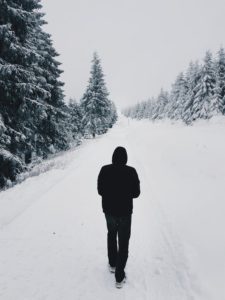Staying Safe While Walking In The Snow.

Each and every year, 1 million people are hospitalized because of injuries sustained after falling, and 17,000 of those 1 million people die. The likelihood of being hospitalized because of a fall increases dramatically in the winter because of the hazards it can put in the street and on the sidewalk. Simply put, walking in a winter wonderland is a dangerous thing. However, by equipping yourself with the knowledge of how ice and snow can cause you to fall and taking steps(no pun intended) to prevent it, you can easily avoid becoming one of those 1 million.
How ice and snow cause you to fall
Believe it or not, ice and snow aren’t the direct cause of a fall. The “slipperiness” of ice occurs because of heat and friction on the top layer of ice. Ice and snow, when layered, are very solid at the bottom and fairly weak at the top. When heat or friction, such as that caused by a pair of boots, is applied to the looser top layer of ice or snow, it causes melting. When the top layer melts, it leaves a thin veneer of water that is nearly imperceptible, but incredibly dangerous. Think about polar ice caps, glaciers, or a frozen lake. You can safely walk on these things because they are in conditions so cold, and the ice is so deep, that the thin layer of water doesn’t form. Walking on ice is like walking on a hardwood floor that’s just been waxed.
This is also what makes “black” ice more dangerous. Black ice isn’t actually different from any other ice scientifically. It’s simply thinner, and because of that, more translucent. This translucency makes it near impossible to see, which obviously adds to the danger. Being thinner is the true killer, though—black ice can melt very quickly, and in some cases will already have the thin layer of water before you step on it.
Snow has its own set of problems separate from ice. The biggest differentiating factor is that snow doesn’t fall as one solid sheet, but instead in flakes. Once it’s on the ground, this causes the snow to work more like sand than concrete. This means that when weight is placed on one area of the snow, it will fall through. This idea is what makes snowshoes work: by spreading your weight across a bigger surface area, it leaves you less likely to apply too much weight in one area.
Contrary to ice, this makes snow more dangerous when it’s warmer outside. You may have heard the term “packing snow” to describe snow that is good for snowballs, snowmen, snow forts, and any other thing a child can come up with. This snow is more likely to stick together because it is, in a way, stuck between water and snow, and will cling to the moisture around it, whether that be other snow or more water in the air.
How to prevent falling on ice and snow
In the winter, the best thing you can do to prevent yourself from falling on ice and snow is to be prepared for it. Other things may help, but the most impactful way to keep from falling is to remove the hazards as they come. If there is snow on the sidewalk, break out the snowblower. If there is ice on your stoop, get the salt out.
If you find yourself tasked with ice or snow outside of your house, you should make a few changes to the way you’re walking. First, take a second to consider your path and what you’ll be crossing. Then move your feet so they are at least a foot apart to provide proper support, and add on to this by keeping your knees bent just a little to lower your center of gravity. Next, carefully make your first step, moving your feet slowly and keeping them at a safe distance when possible. You can continue from there, and soon you’ll be safely on the other side. If you have a technique already like dragging your feet or shuffling, you can keep using it but you should still be applying these ideas.
If walking on snow and ice is a problem for you, or you think it may be a problem, you may want to work on your balance. It may seem like the type of thing you can’t improve, but that simply isn’t true. Of course, it is always our recommendation that you look for help from a professional in crafting a safe and healthy exercise plan, but anything from yoga to weightless squats can keep you safe this winter.
